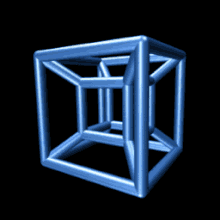Rotations in 4-dimensional Euclidean space
In mathematics, the group of rotations about a fixed point in four-dimensional Euclidean space is denoted SO(4).For the sake of uniqueness, rotation angles are assumed to be in the segment [0, π] except where mentioned or clearly implied by the context otherwise.In that case of a double rotation, A and B are the only pair of invariant planes, and half-lines from the origin in A, B are displaced through α and β respectively, and half-lines from the origin not in A or B are displaced through angles strictly between α and β.[2] Assuming that a fixed orientation has been chosen for 4-dimensional space, isoclinic 4D rotations may be put into two categories.To see this, consider an isoclinic rotation R, and take an orientation-consistent ordered set OU, OX, OY, OZ of mutually perpendicular half-lines at O (denoted as OUXYZ) such that OU and OX span an invariant plane, and therefore OY and OZ also span an invariant plane.We make the convention that the rotation senses from OU to OX and from OY to OZ are reckoned positive.However, when another isoclinic rotation R′ with its own axes OU′, OX′, OY′, OZ′ is selected, then one can always choose the order of U′, X′, Y′, Z′ such that OUXYZ can be transformed into OU′X′Y′Z′ by a rotation rather than by a rotation-reflection (that is, so that the ordered basis OU′, OX′, OY′, OZ′ is also consistent with the same fixed choice of orientation as OU, OX, OY, OZ).Therefore, once one has selected an orientation (that is, a system OUXYZ of axes that is universally denoted as right-handed), one can determine the left or right character of a specific isoclinic rotation.All left-isoclinic rotations form a noncommutative subgroup S3L of SO(4), which is isomorphic to the multiplicative group S3 of unit quaternions.The identity rotation I and the central inversion −I form a group C2 of order 2, which is the centre of SO(4) and of both S3L and S3R.SO(4) is commonly identified with the group of orientation-preserving isometric linear mappings of a 4D vector space with inner product over the real numbers onto itself.With respect to an orthonormal basis in such a space SO(4) is represented as the group of real 4th-order orthogonal matrices with determinant +1.A point in 4-dimensional space with Cartesian coordinates (u, x, y, z) may be represented by a quaternion P = u + xi + yj + zk.A left-isoclinic rotation is represented by left-multiplication by a unit quaternion QL = a + bi + cj + dk.In matrix-vector language this is Likewise, a right-isoclinic rotation is represented by right-multiplication by a unit quaternion QR = p + qi + rj + sk, which is in matrix-vector form In the preceding section (isoclinic decomposition) it is shown how a general 4D rotation is split into left- and right-isoclinic factors.The four eigenvalues of a 4D rotation matrix generally occur as two conjugate pairs of complex numbers of unit magnitude.The conjugate of that eigenvalue is also unity, yielding a pair of eigenvectors which define a fixed plane, and so the rotation is simple.Its rotation group SO(3) is identified with the subgroup of SO(4) consisting of the matrices In Van Elfrinkhof's formula in the preceding subsection this restriction to three dimensions leads to p = a, q = −b, r = −c, s = −d, or in quaternion representation: QR = QL′ = QL−1.Without loss of generality, this axis may be chosen as the z-axis of a Cartesian coordinate system, allowing a simpler visualization of the rotation.Without loss of generality, these axis planes may be chosen to be the uz- and xy-planes of a Cartesian coordinate system, allowing a simpler visualization of the rotation.[7] The trajectory of a point can be written as a function of time as {ξ10 + ω1t, η0, ξ20 + ω2t} and stereographically projected onto its associated torus, as in the figures below.


Fig.1: simple rotations (black) and left and right isoclinic rotations (red and blue)
Fig.2: a general rotation with angular displacements in a ratio of 1:5
Fig.3: a general rotation with angular displacements in a ratio of 5:1
All images are stereographic projections .
mathematicsfour-dimensional Euclidean spacespecial orthogonal grouprotationcompletely orthogonalHalf-linesTesseractstereographic projectionClifford torusVillarceau circleorthogonalinvariantinversescentral inversionnoncommutativecompactLie groupcommutativesubgroupisomorphicconjugatemaximal torimultiplicative groupquaternionscommutesdirect productnormal subgroupsfactor groupsuniversal covering groupdouble covercentrereal projective space3-spheresimple groupsfactor groupconjugationReflectionsorientationisometriclinearvector spaceinner productreal numbersorthonormalorthogonal matricesdeterminantEuclidean normidentity matrixCartesian coordinatesquaternionFelix Kleinassociativeeigenvaluescomplex numbersrotation group SO(3)Euler–Rodrigues formulaEuler–Rodrigues parametersHamiltonCayleyspherical coordinateshyperspherical coordinatesstereographic projectionsstereographically5-cellorthographic projectionRodrigues' rotation formulaskew-symmetric matrixLaplace–Runge–Lenz vectorLorentz groupOrthogonal groupOrthogonal matrixPlane of rotationPoincaré groupQuaternions and spatial rotationBibcodeEuclidHilbertHathaway, Arthur S.Transactions of the American Mathematical SocietyStringham, Irving